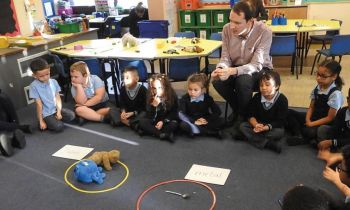School improvement planning is a tricky beast. Leaders of genuinely successful schools know that rigorous development documentation is vital. Without it, then at best you’ll end up with changes that are patchy and piecemeal. At worst, improvements can disappear completely while the school stagnates.
The process of evaluating provision and identifying how to improve involves assembling a complex jigsaw. At the same time, you’ll be treading on eggshells (mindful of the professional pride that everyone holds in the work that they do) and dodging the thunderbolts (maintaining compliance with ‘On high’, be it an LA, trust or ultimately the government).
It can be tempting to simplify the whole process by sacrificing it on the altar of data. It might appear in various forms – ‘performance’, ‘progress’, ‘big data’, ‘metadata’ – but this 21st-century deity can only be conquered with the aid of complex ICT modelling. Successive governments and inspection frameworks have conspired to reinforce data’s omnipotence, so that the success of almost every school is each year defined against its latest set of assessment results. Ever-increasing scores are expected as standard, with any given cohort’s achievements forming nothing more than the baseline for their successors.
WE ARE NOT ROBOTS
However, our lives and those of the children in our charge are not like that. They are narratives, not spreadsheets. We have emotions, feelings and moral codes; we are not robots.
Of course, it’s of paramount importance that all children give of their best academically, and that schools have rigorous procedures in place to ensure this happens – yet the contributions that pupils make now as students, and in the future as citizens of mutually supportive, empathetic communities, require skills and talents that can never be judged or monitored by computation alone.
At Hurlingham School in Putney, our development cycle is influenced by three separate groups of stakeholders who come together to make our school the special place that it is – pupils, staff and parents.
Whilst everyone’s views are welcomed and valued throughout the academic year, we place particular emphasis on one specific group in each term. In summer we undertake a detailed web-based survey of parents.
During autumn it’s the turn of the children, who express their views through the School Council. However it’s in the spring term that we glean some of the most valuable – and telling – information. This is when our focus turns to the staff, including the support and administrative teams as well as teachers. We hold a training day immediately after the Christmas holidays that’s entirely dedicated to this and which follows a specific structure.
First, we split up into groups and complete an enjoyable, competitive team-building exercise. At any other time in the academic year this would run the risk of being viewed as something of a distraction from activities with more immediate relevance to school life, but when we’ve just returned from the Christmas break this doesn’t seem to apply.
Instead, it feels pleasant to have something akin to a festive game as the first activity after the holidays! Different clues and pieces of information are provided to every member of each team, and by working together efficiently, collaborating, empathising and communicating with others, results are gained and solutions found.
The tasks themselves are not set within a school framework, but instead highlight key collaboration and team working skills that promote appropriate mindsets for both the activities to come and ongoing institutional success.
With the simulation exercise complete (and a box of chocolates awarded to the winning group), the focus changes to the moral purpose of education, with staff guided to reflect on why they chose to work in a school. The atmosphere in the room then changes quite considerably – the skills required to complete the team-building exercise remain in everyone’s minds, but the imperative and calling that influenced colleagues’ decision to work in education are also remembered.
We circulate a list of thought-provoking questions, and each individual can choose whether they are going to think about the answers, discuss them with a friend or write them down. If they commit their thoughts to paper, they have the choice at the end of the session to shred their jottings, keep them to inform their next review meeting or pass them on to a member of SLT.
SWOTTING UP
Once a significant amount of time has been spent considering the self-reflection questions, ‘Strengths, Weaknesses, Opportunities and Threats’ (SWOT) analysis sheets are given out and staff are asked to think about what the school means to them.
They then proceed to record any SWOT details they’re aware of regarding the school, before the sheets are compiled into a single document for later discussion by SLT.
The ‘weaknesses’ and ‘opportunities’ boxes invariably deliver at least two or three golden nuggets of thinking each year that immediately get transposed into subject, key stage or whole-school planning. The document also helps us identify misconceptions that can be rectified at future staff meetings.
Once the compulsory SWOT analysis has ended, we distribute an optional reflection sheet that contains various ‘thought bubbles’ that individuals can fill with thoughts concerning their school career and responsibilities if they wish.
Obviously, we regularly discuss such matters with the individuals concerned as part of our ongoing performance management review process – but the particular atmosphere and comparatively relaxed framework of the self-reflection day often helps to encourage staff to voice opinions and thoughts that are both creative and original. In this way, it is through recognising and valuing the essential humanity of our key stakeholders that Hurlingham manages to tame the school improvement beast.










